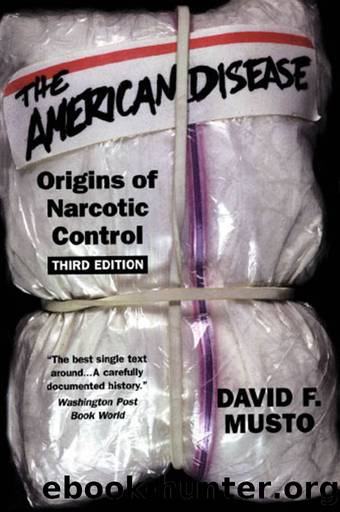The American Disease by David F. Musto

Author:David F. Musto [Musto, David F.]
Language: eng
Format: epub
Tags: Foreign Policy, Drug Policy, Narcotics, Drugs, Heroin, Opioids, 20th Century
Publisher: Oxford University Press
Published: 1999-04-22T04:00:00+00:00
While most spokesmen for the drug trades opposed federal regulation of cannabis, one distinguished member favored its control and most of the other provisions of the new legislation: Dr. William Jay Schieffelin of New York, who moved with the progressive and reform spirit of the era and was therefore somewhat apart from the rank and file of his colleagues in the drug trade. Schieffelin believed that cannabis was âused only to a slight extent in this country,â but he had heard that there was a demand for it in the Syrian colony in New York, where he thought it was smoked like prepared opium. He concluded that the evil was small but that cannabis ought to be included in the bill.11
But cannabis was not included finally, and except for the Pure Food and Drug Actâs provision for labeling, no federal regulatory law was enacted until 1937. Meanwhile the two contrasting attitudes toward cannabis remained pretty much the sameâthe reformers feared its use; the drug industry felt less concern about possible misuse and opposed its regulation.
Still, complaints about cannabis continued to come to the attention of the federal government. One of the American delegates to the First Hague Conference, Henry Finger, drew particular attention: Californians, especially in San Francisco, were frightened by the âlarge influx of Hindoos . . . demanding cannabis indicaâ who were initiating âthe whites into their habit.â Finger wanted the world traffic in cannabis to be controlled.12 The United States delegation gladly adopted Fingerâs goal but did not find the Hague Conference favorably disposed. The best the United States could accomplish was the adoption of a recommendation that other nations look into the character of the drug.13 Agreement that international traffic in cannabis should be regulated did not come until the Second Geneva Convention in 192.5.14
Domestic concern over cannabis seemed to originate in the Southwest and to begin increasing after World War I. John M. Parker, governor of Louisiana, and Dr. Oscar Dowling, president of Louisianaâs Board of Health, argued that cannabis also ought to be controlled. Their reaction to marihuana had elements which would become familiar in the 1930s. A white, 21-year-old musician in New Orleans had been arrested for forging a physicianâs signature in order to get some âmariguanaâ imported from Mexico. The musician said the substance was taken to âmake you feel good,â but its dangers seemed clear to Dowling and Parker. Dowling warned the governor that marihuana was âa powerful narcotic, causing exhilaration, intoxication, delirious hallucinations, and its subsequent actions, drowsiness and stupor.â He also urgently requested of the Surgeon General of the Public Health Service that the federal government take âsome actionâ to control the traffic in marihuana.15 On 26 November 1920 Governor Parker wrote to Prohibition Commissioner John F. Kramer that âtwo people were killed a few days ago by the smoking of this drug, which seems to make them go crazy and wild,â and he expressed his surprise that there were no restrictions against marihuana. But the trouble the government
Download
This site does not store any files on its server. We only index and link to content provided by other sites. Please contact the content providers to delete copyright contents if any and email us, we'll remove relevant links or contents immediately.
| Administration & Medicine Economics | Allied Health Professions |
| Basic Sciences | Dentistry |
| History | Medical Informatics |
| Medicine | Nursing |
| Pharmacology | Psychology |
| Research | Veterinary Medicine |
When Breath Becomes Air by Paul Kalanithi(7253)
Why We Sleep: Unlocking the Power of Sleep and Dreams by Matthew Walker(5636)
Paper Towns by Green John(4163)
The Immortal Life of Henrietta Lacks by Rebecca Skloot(3820)
The Sports Rules Book by Human Kinetics(3581)
Dynamic Alignment Through Imagery by Eric Franklin(3481)
ACSM's Complete Guide to Fitness & Health by ACSM(3459)
Kaplan MCAT Organic Chemistry Review: Created for MCAT 2015 (Kaplan Test Prep) by Kaplan(3418)
Introduction to Kinesiology by Shirl J. Hoffman(3297)
Livewired by David Eagleman(3113)
The River of Consciousness by Oliver Sacks(2988)
Alchemy and Alchemists by C. J. S. Thompson(2908)
The Death of the Heart by Elizabeth Bowen(2895)
Descartes' Error by Antonio Damasio(2728)
Bad Pharma by Ben Goldacre(2722)
The Gene: An Intimate History by Siddhartha Mukherjee(2487)
Kaplan MCAT Behavioral Sciences Review: Created for MCAT 2015 (Kaplan Test Prep) by Kaplan(2483)
The Fate of Rome: Climate, Disease, and the End of an Empire (The Princeton History of the Ancient World) by Kyle Harper(2429)
The Emperor of All Maladies: A Biography of Cancer by Siddhartha Mukherjee(2427)
